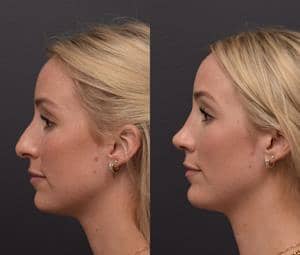Conservative techniques create the most natural results
Ear prominence is the most common congenital deformity in humans. Correcting the prominent ear (a form of otoplasty) is usually a very gratifying procedure for both the patient and the surgeon (Figure 1, page 48). The purpose of this article is to discuss the evaluation and management of the typical patient presenting for correction of the prominent ear. The goal of the procedure is to reposition the ear while leaving as natural a contour to the ear structure as possible.
There is no aesthetic ideal or, for that matter, “normal” standard for ears. It is instructive to observe the natural variations among individuals who are content with their ears. I have found that the evolution of otoplasty during the last few decades has been somewhat analogous to the evolution of rhinoplasty during the same period. Greater emphasis has been placed on conserving cartilaginous structures instead of excising them, and on carefully reshaping the existing structures to minimize—and ideally to prevent—contracted or irregular contours.
The Consultation
My youngest aesthetic plastic surgery patients are individuals who desire less-prominent ears. However, I see people of all ages with this condition, and I have occasionally combined otoplasty with facelift surgery. The consultation is the same as for any other patient who seeks aesthetic surgery, in that it begins with a detailed medical history followed by a careful interview of the patient.
I want to hear expectations about the procedure and its results, even from children. I expect a child who has reached school age to be able to express an understanding that the process will entail a surgical procedure and a recovery with some discomfort, with the goal that the ears will become less prominent. I also want to hear the child express enough motivation for the procedure to convince me that—in his or her mind—the benefits will outweigh any anxiety he or she may have. I look for realistic expectations from parents and adult patients concerning the procedure, recovery, and expectations.
The Evaluation
The next step is a careful evaluation of the patient. The age of the patient will suggest the strength and rigidity of the cartilage, but age is not an absolute indicator. The thickness and resilience of the cartilage can differ substantially among individuals of the same age. There may even be significant variation between the left and right sides of the same individual. Therefore, palpation to test exactly how the cartilage of each ear “gives” when folded is critical to planning the surgery.
While testing the cartilage, I carefully assess the cause of the prominence. The two structures that contribute to prominence are the antihelix and the concha. I almost always see some degree of insufficient folding of the antihelix. The concha may be extremely deep, set at an excessively open angle to the mastoid, or both. I also note the degree of prominence of the lobule.
I then discuss the goals and nature of the surgery with the patient. A prospective patient needs to understand that there is no normal standard for ears and that a wide range of ear appearance is acceptable.
That Elusive Symmetry
During the discussion of goals, emphasis is placed on symmetry. Profound asymmetry in patients presenting for prominent ears is common. Often, the patient requests that the more prominent ear is made the same as the other one. As I do when I discuss surgery on any paired body part, I carefully explain to the patient that, al-though the goal is to improve symmetry, perfect symmetry is never possible.
In otoplasty surgery, I find it useful to think that there are two types of symmetry. One is the degree of offset, or prominence, that the ear has relative to a specific part of the head when compared to the other side. The other is the ear’s appearance from the side on the basis of its structures, such as its helix and antihelix.
During the preoperative consultation, patients are typically concerned with the first type. They may not consider, or may take for granted, the second, and will scrutinize the ear structures for symmetry only after the surgery. Therefore, it is important to discuss both types of symmetry with the patient before surgery. This is especially important if the ears are profoundly asymmetrical, and one ear has rudimentary or completely lacking helical and antihelical folding. These individuals should be told that there will be differences between the ears’ side appearances after surgery.
With respect to the degree of symmetry of prominence from the head, I explain that “normal” individuals often vary by 2–3 mm, and that, while I strive to create perfect symmetry at the conclusion of the procedure, variation within this range should be acceptable.
Planned Overcorrection

In my experience, patients seeking otoplasty are often very concerned about the scar. For this reason, I use the more traditional posterior approach even though others have taken the anterior approach with consistent success.2 I place the incision at the sulcus. Patients are most reassured when I explain that I will place the incision where the skin naturally creases.
During the consultation, I discuss anesthesia options. Patients may, of course, have the surgery under general anesthesia or any degree of sedation. I typically perform this procedure using only light sedation (1–2 mg of oral lorazepam) and local anesthesia; some patients are not sedated at all.
I carefully explain to the patient that the local infiltration will sting or burn for approximately 1 minute on each side while I numb completely around the ear. I then explain that that will be the only thing that will hurt during the entire procedure. If the patient—even a child—accepts this, we will proceed.
The Procedure
The patient is prepared sterilely and draped to include both ears. Each ear is then infiltrated circumferentially with 4–5 mL of 1% lidocaine with epinephrine buffered with bicarbonate. After I allow sufficient time to pass to maximize vasoconstriction, I make the initial incision.

I then undermine laterally to expose the antihelix. If concha setback is planned, I also undermine medial to the incision to elevate the concha. Minimal hemostasis is obtained with a bipolar cautery to minimize inflammation of the cartilage.
I then turn my attention to shaping the antihelical fold. Most adults require some weakening of this cartilage to create a new fold; therefore, only gentle rasping or abrading is re-quired.3 Thorough incision of the cartilage or even excision of the cartilage will lead to an unnatural sharp edge instead of a natural gentle curve to this contour. Overly aggressive rasping or abrading may also make the cartilage fold too sharply to give a natural result.
I inspect the lateral surface to determine the location of the fold, and I mark the fold by placing two or three 25-gauge needles at its midpoint. I then position the ear and place three to five Mustarde mattress sutures along the course of the fold using a clear 5-0 nylon suture, which is then tightened to create the degree of folding.4
Concha Versus Antihelix
I release the ear and evaluate the new degree of elevation from the head. I usually also set the concha back to some degree. Even if an acceptable degree of projection can be attained solely by folding the antihelix, I feel that—particularly in adults with stiffer cartilage—I can achieve a more natural look by combining less-aggressive antihelix folding with some concha setback (Figure 2).
Sufficient setback can usually be accomplished by removing any mastoid soft tissue that is immediately below and slightly posterior to the initial position of the concha. This allows the concha to be positioned not only medially but also slightly posteriorly to prevent narrowing of the meatus. Two or three sutures are usually used to maintain the position.5 If further setback is needed, I excise the posterior prominences of the concha.
I remove additional skin, if necessary, but I take care to ensure that there will be no tension to the closure. I then perform the procedure on the other side with careful comparison to the first side, including measuring the distance from the head at two or three locations to obtain symmetry. I close using a running 5-0 nylon suture. As stated above, the decrease in prominence is overcorrected by 2–3 mm. Interestingly, most patients are so concerned with reducing the prominence that they accept the overcorrection immediately.
Soft gauze is applied to conform to the external ear, and a standard compression wrap is applied. This initial bandage is typically left in place for 72 hours. Once it is removed, the patient is instructed to wear a nightly wrap over the ears for 3–4 weeks. The external sutures are removed at 1 week.
Plan for Success
Otoplasty is a procedure with a high degree of satisfaction for both patient and surgeon. As with any aesthetic procedure, realistic patient expectations and careful preoperative planning are the foundation for good results. Surgeons should strive for the most natural results possible by emphasizing shaping and not excision of cartilaginous structures. PSP
Curtis Perry, MD, is in private practice in East Greenwich, RI. He is an assistant clinical professor at Tufts University School of Medicine in Boston. He can be reached at (401) 541-7170 or [email protected].
References
1. Messner AH, Crysdale WS. Otoplasty. Clinical protocol and long-term results. Arch Otolaryngol Head Neck Surg. 1996;122:773–777.
2. Erol OO. New modification in otoplasty: Anterior approach. Plastic Reconstr Surg. 2001;107:193–202.
3. Dicio D, Castagnetti F, Baldassarre S. Otoplasty: Anterior abrasion of ear cartilage with dermabrader. Aesthetic Plast Surg. 2003;27: 466–471.
4. Mustarde JC. Correction of prominent ears using buried mattress sutures. Clin Plast Surg. 1978;5: 459–469.
5. Furnas D. Correction of prominent ears by conchamastoid sutures. Plastic Reconstr Surg. 1968;42: 189–193.



